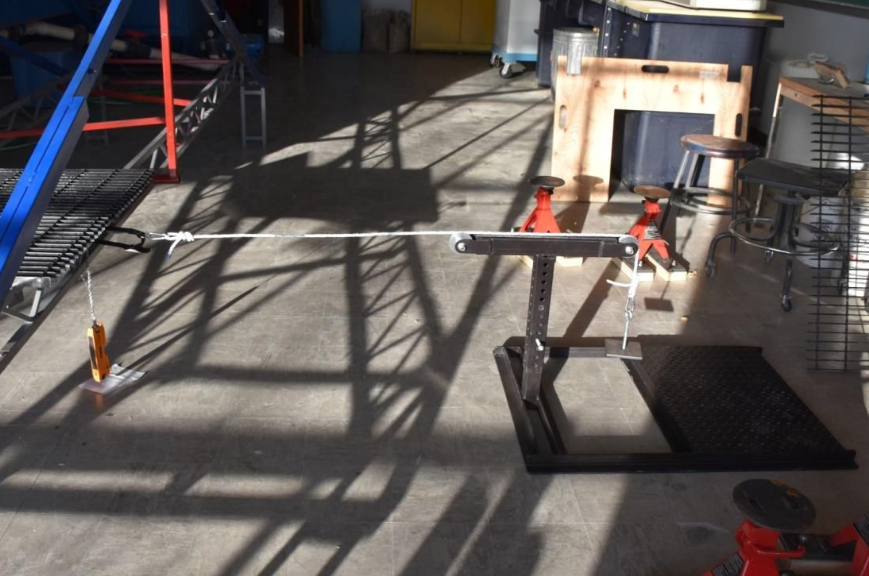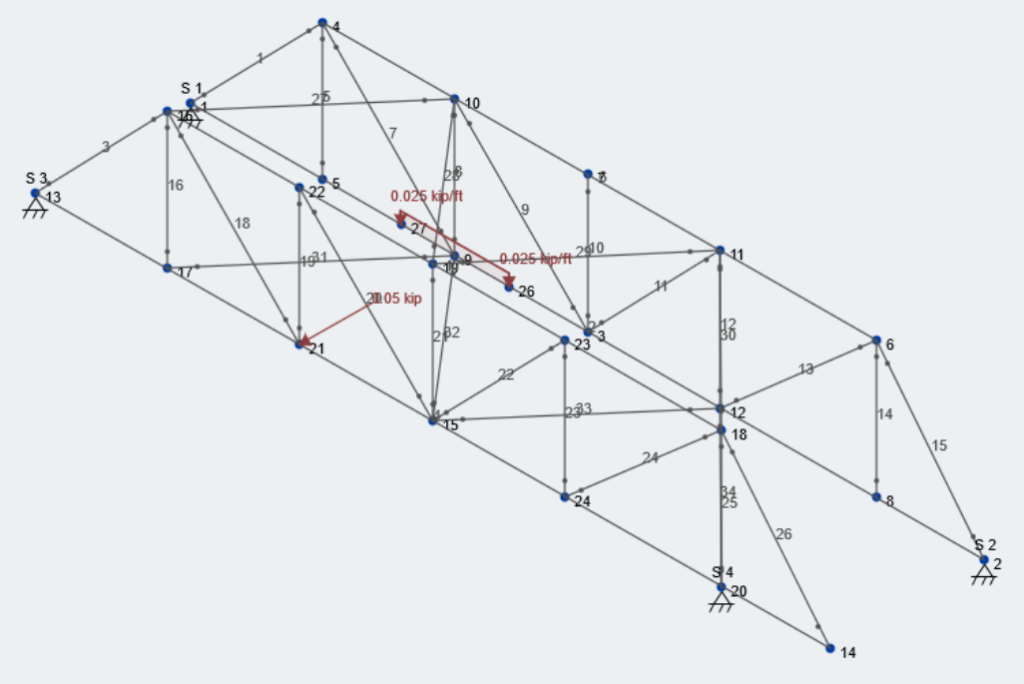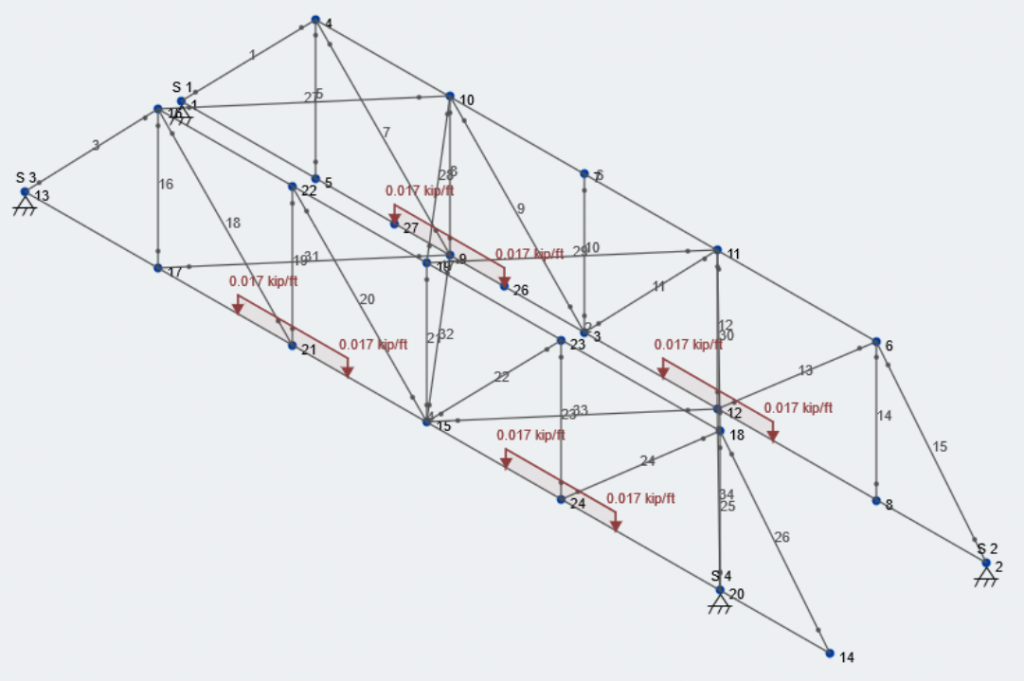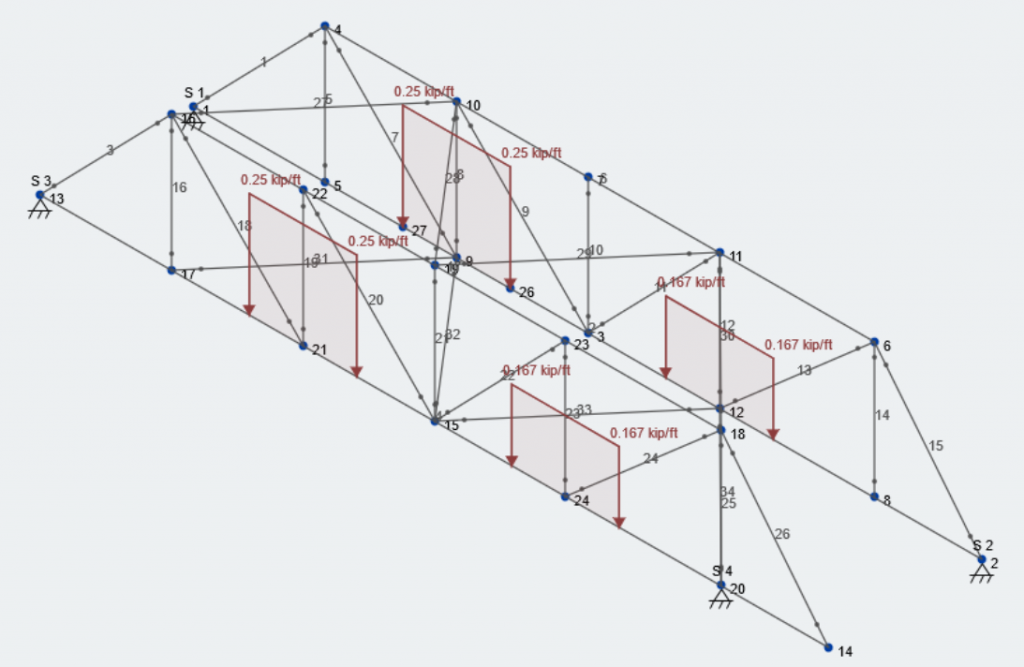Un'introduzione alle capacità di analisi e progettazione di una struttura di ponte per il concorso studentesco AISC per ponti in acciaio
Quasi tutto l'anno, le università degli Stati Uniti ospitano le rispettive squadre e club AISC Student Steel Bridge che competono nel Concorso AISC Student Steel Bridge. Ciò comporta un viaggio lungo un anno accademico per progettare e costruire un ponte in scala modello che viene testato in varie condizioni di carico e altri criteri di valutazione. Per gli studenti, questo processo include tutto, dalla raccolta fondi alla progettazione preliminare del ponte, all'ordinazione, realizzazione e assemblaggio del ponte. Patrocinato e facilitato dall'AISC, il concorso Student Steel Bridge offre agli studenti un'idea dell'approvvigionamento ingegneristico nel mondo reale, processi di progettazione e revisione.
Un aspetto molto importante del processo – si potrebbe dire più rilevante per il lavoro post-laurea – è l'analisi e la modellazione della struttura del ponte. I software di ingegneria strutturale svolgono un ruolo importante fornendo agli studenti la possibilità di analizzare rapidamente e prendere decisioni sui progetti dei ponti durante tutto il processo di progettazione.
SkyCiv Structural 3D offre agli studenti la perfetta combinazione di potenza analitica e adattabilità. SkyCiv è orgoglioso del tempo di avvio ridotto necessario per apprendere il software e utilizzarlo in modo efficace, portando a più tempo aggiungendo valore ai loro progetti, e anche prima.
analisi ed esecuzione dei controlli strutturali in acciaio su questo progetto, Diamo un'occhiata al progetto preliminare di una struttura a ponte per il concorso AISC Student Steel Bridge.
Modellazione della struttura reticolare
Utilizzando i documenti sui vincoli dell'involucro del ponte forniti da AISC nell'AISC Student Steel Bridge – 2019 Regole, osserviamo quanto segue:

figura 1: Disegno della busta del ponte in acciaio per studenti AISC
(fonte: Concorso AISC Student Bridge in acciaio 2019 Regole)
Utilizzeremo un Pratt Truss per il nostro esempio. Fare clic sui collegamenti per ulteriori informazioni su Tipi di traliccio e Modellare una capriata. Analizzeremo i traversi come un singolo membro per semplificare il nostro modello in questa fase. È possibile modellare facilmente traverse più complesse man mano che gli studenti avanzano nel processo di progettazione.
Osservando la sezione del ponte, assumeremo che il livello del suolo sia l'elevazione Y di 0, e il baricentro del nostro cosciale passa attraverso un'elevazione Y di 1 piede. Osservando il prospetto laterale, supponiamo che i nostri supporti siano centrati su ciascuno dei 1′-0″ posizioni di ampia portata. Questo ci darebbe una lunghezza della traversa inferiore di 22 piedi. Per la traversa superiore del nostro traliccio del ponte, diciamo che il suo baricentro passa attraverso l'elevazione Y di 4.75 ft. Infine, supporremo che ci siano sei spazi uguali tra le estremità dei nostri traversi inferiori, quindi la spaziatura della posizione della nostra connessione tralicciata è 22 piedi/6 = 3.67 ft.
Ora che abbiamo le dimensioni generali dell'involucro del nostro ponte, creiamo i nodi. Ecco la nostra tabella dei nodi, dove la direzione X è la dimensione lunga della travatura reticolare e la direzione Y è l'elevazione.

Successivamente, Disegniamo i membri tra questi nodi con il modello di traliccio Pratt. Assicurati di selezionare il “travatura” pulsante sulla finestra di sinistra durante la creazione dei membri in modo che le estremità dei membri vengano rilasciate momentaneamente. Ecco il nostro traliccio Pratt:

Ora aggiungiamo alcuni supporti. Diamo un'altra occhiata al disegno della busta del ponte AISC, il piede destro si trova verso l'interno dalla fine del ponte, creando un cantilever. Per accogliere questo, spostiamo Node 6 e nodo 8 per allinearsi con la posizione di questo supporto; Il centro del basamento è 3′-0″ verso l'interno dalla corsa giusta, quindi sarà la nostra dimensione X 19 piedi. Infine, aggiungiamo i supporti dei pin su N0de 1 e nodo 8. Dai un'occhiata al nostro traliccio aggiornato:

Successivamente, ripetiamo la nostra struttura reticolare per tutta la larghezza del ponte. Questo può essere fatto selezionando l'intera struttura, inclusi nodi e supporti, e andando a modificare – Duplicare. Guardando ancora la figura 1, assumeremo che le capriate saranno centrate su ciascun lato dell'involucro del ponte. Pertanto, saranno distanziati di 4′- 3 1/2″, o 4.22 ft, questa è la nostra dimensione di duplicazione. Dobbiamo anche regolare i supporti come indicato in Figura 1, la capriata sinistra ha il suo sostegno all'estremità del ponte. Dopo aver duplicato la nostra struttura reticolare lungo l'asse laterale (La resistenza alla compressione sarà considerata come da AS4600), la nostra struttura 3D ora assomiglia a questa:

Adesso, dobbiamo collegare la nostra struttura utilizzando rinforzi laterali per completare la modellazione preliminare della struttura del nostro ponte. Questa parte del progetto è in qualche modo un processo iterativo per gli studenti; proveranno a individuare i punti corretti per collegare insieme ciascuna trave reticolare per ridurre al minimo l'oscillazione laterale, la metrica principale valutata durante il caso di carico laterale. Inseriamo un po' di rinforzo diagonale tra i traversi superiore e inferiore delle capriate. Per esempio, come mostrato dalla vista dall'alto:

La modellazione nel modulo 3D strutturale di SkyCiv è estremamente intuitiva e porta ad analisi più rapide e risultati più semplici. Dai ai tuoi studenti la possibilità di provare a modellare una capriata in 2D utilizzando il nostro Strumento gratuito di calcolo della progettazione di tralicci.
Applicazione di carichi al nostro ponte
Dopo la modellazione, ora possiamo iniziare ad applicare i carichi stabiliti da AISC. Esistono due tipi di carico, o casi di carico, su cui verrà testato il ponte: Laterale e verticale. Le magnitudo di ciascun caso di carico sono fornite da AISC, ma la loro posizione esatta lungo la lunghezza del ponte non lo è. Pertanto, gli studenti dovranno analizzare più posizioni diverse per ciascun caso di carico per scoprire lo scenario peggiore per ciascuno. Va notato che ogni caso di carico viene applicato in modo indipendente; la struttura non vede entrambe le situazioni di carico contemporaneamente.
Perché i carichi forniti da AISC lo sono REALE carichi che verranno utilizzati nella competizione, possiamo supporre che siano carichi di servizio. Stiamo cercando di progettare questo ponte nel modo più leggero possibile pur rispettando i criteri di deflessione. perciò, le nostre combinazioni di carico non includeranno alcun fattore di carico amplificante.
Caso di carico laterale
Per il caso di carico laterale, Guardiamo il disegno di carico fornito da AISC nel 2019 Regole (figura 2):

figura 2: Piano di prova di carico laterale per la competizione AISC Student Bridge in acciaio
(fonte: Concorso AISC Student Bridge in acciaio 2019 Regole)
Primo, noti che non solo c'è a 50 libbra di forza laterale sul lato di guida, ma c'è un 75 carico verticale di libbra sul lato sinistro nella stessa posizione relativa lungo la lunghezza del ponte. Secondo, Nota 2 afferma che la posizione “S” è determinato in modo casuale. Durante i test, AISC utilizza una griglia/pavimentazione in metallo per sostenere il peso e un punto di ancoraggio per la forza laterale:

fonte: Guida al concorso AISC per i partecipanti
Per questo esempio, applicheremo il 50 carico laterale lb sul “Nodo 21″ del nostro modello. La 75 Il carico verticale lb sul lato opposto verrà applicato come carico distribuito uniformemente su 3′-0” larghezza del piano di calpestio.
\(Laterale:Carica = 50\:libbre = 0.05\:ciao)
\(Verticale:Carico=75:lb/3\:ft = 25\:libbre/piedi = 0.025\:kip/ft\)
Come menzionato prima, questi sono carichi di servizio, quindi entrambi questi carichi si verificheranno nel caso di carico che abbiamo creato chiamato “Caso di carico laterale” e verrà preso in considerazione Carico in tempo reale. La successiva combinazione di carico sarà LC #1 ed è il seguente:
\(LC\:1=1.0*Self\:Weight\:of\:Struttura + 1.0*Laterale:Load\:Case\)
Ancora una volta, gli studenti dovranno applicare il carico laterale e verticale in più punti lungo la lunghezza del ponte per individuare la posizione che fornisce i risultati dell'analisi determinante. Ecco come apparirà il nostro modello con questi carichi applicati:

Caso di carico verticale
Per il caso di carico verticale, Guardiamo il disegno di carico fornito da AISC nel 2019 Regole (figura 2):

figura 3: Piano di prova del carico verticale per il concorso AISC Student Bridge in acciaio
(fonte: Concorso AISC Student Bridge in acciaio 2019 Regole)
Simile al caso di carico laterale, i punti in cui agiscono i carichi verticali non sono direttamente indicati. Questa volta, ci sono due casi di carico separati che dobbiamo valutare. Primo, c'è il 100 condizione di precarico lb. Poi, l'addizionale 1400 e 900 le libbre vengono aggiunte per equivalere a a 1500 e 1000 carico libbre rispettivamente, come mostrato in figura 3. Assumeremo che i carichi siano trasportati uniformemente tra le capriate, e che agiscono come un carico uniformemente distribuito sulla lunghezza del piano di calpestio. Anche, identificheremo tutti i carichi verticali come Carico in tempo reale.
Il precaricamento sarà un caso di carico proprio e verrà chiamato “Caso di carico verticale – Precaricamento”. Applichiamo i carichi distribuiti centrati sul Nodo 21/9 e nodo 24/12. Nodo 24 e 12 sono specchiati al centro del ponte.
\(Precarico = (100\:libbre/2)/3\:ft = 16.7\:libbre/piedi = 0.0167\:libbre/piedi)
Successivamente, la combinazione di carico è:
\(LC\:2=1.0*Self\:Weight\:of\:Struttura + 1.0*Verticale:Load\:Case-Preload\)
Ecco come appare il nostro modello con la custodia di precaricamento:

Adesso, aggiungiamo il carico rimanente. Sul lato sinistro c'è ora il carico totale 1500 libbre, e sul lato destro c'è adesso 1000 libbre. Lo salveremo come un altro caso di carico chiamato “Caso di carico verticale – Totale”.
\(Total\:Load\:on\:Left\:Side\: = (1500\:libbre/2)/3\:ft = 250\:libbre/piedi = 0.25\:kip/ft\)
\(Total\:Load\:on\:Right\:Side\: = (1000\:libbre/2)/3\:ft = 167\:libbre/piedi = 0.167\:kip/ft\)
La nostra ultima combinazione di carico è quindi identificata come:
\(LC\:3=1.0*Self\:Weight\:of\:Struttura + 1.0*Verticale:Load\:Total\)
Ecco come appare il nostro modello con il carico totale applicato nel caso di carico verticale:

Vedi sotto per un'immagine di una recente competizione e il meccanismo di carico per il caso di carico verticale:

fonte: Guida al concorso AISC per i partecipanti
Analisi dei casi/combinazioni di carico
L'ultima parte di questo esercizio consiste nell'eseguire l'analisi sulla struttura del nostro ponte e nell'interpretare i risultati. Prima di farlo, Diamo un'occhiata alle combinazioni di carico e ai relativi fattori di carico:

Questi carichi sono carichi di servizio, quindi utilizzeremo un fattore di carico di 1.0 su tutti loro. Queste tre combinazioni di carico incapsulano le condizioni di carico presentate tra il caso di carico laterale e il caso di carico verticale, forniti dall'AISC. Adesso, eseguiamo la nostra analisi. Per scopi pratici, esamineremo i risultati assiali per la travatura reticolare destra con l'estremità a sbalzo per LC 3.

SkyCiv dà agli utenti il potere di nascondersi, isolare e visualizzare i risultati delle loro strutture nel modo che ritengono opportuno. Guarda l'intera struttura per un'idea più globale, oppure isolare combinazioni o singoli membri per valutarli a un livello più granulare. Da qui, gli studenti dovranno affrontare il processo di progettazione iterativa e di collaborazione con il proprio team. Gli studenti possono ora concentrarsi su come diventare ingegneri migliori e ben preparati non solo per il concorso AISC Student Steel Bridge, ma come ingegnere in formazione e ingegnere professionista.
Questo esempio mostra quanto può essere potente ma semplice SkyCiv 3D, con i suoi moduli intuitivi rivolti a utenti che vanno dagli studenti di ingegneria del primo anno agli ingegneri principali al culmine della loro carriera. SkyCiv spera che possa essere uno strumento importante da utilizzare in classe, consentendo agli studenti di concentrarsi sull'apprendimento dell'ingegneria piuttosto che sull'apprendimento del software.
Riferimenti:
- “Programmi universitari”. AISC, 2019, www.aisc.org/education/university-programs/student-steel-bridge-competition/.


